Nokia has marked its presence in the tablet industry by introducing entry-level tablets. Nokia tablets have become widely popular among the budget masses with their durable design and user-friendly interface. The Nokia T10 and the Nokia T20 tablets have emerged as popular choices. The Galaxy Tab A7 Lite has been one of the foremost reinventions by Samsung which falls in the budget segment. Here we are comparing the Nokia T10, the Nokia T20, and the Galaxy Tab A7 Lite
Display Comparison
The Nokia T10 features an 8 inches IPS LCD display which has a typical brightness of 360nits. Moreover, it has a resolution of 800 x 1280 pixels.
On the other hand, the Nokia T20 has a 10.4 inches IPS LCD display which has a resolution of 1200 x 2000 pixels. This model has a typical brightness of 400 nits which is higher than the Nokia T10 and offers better visibility outdoors. Its screen has scratch-resistant glass as well. The Galaxy Tab A7 Lite has an 8.7 inches TFT LCD display which has a resolution of 800 x 1340.
Overall, the Nokia T20 offers an immersive visual experience through its high-resolution expansive display. It will deliver clear output compared to the remaining models and will be suitable for high-res video consumption.
Chipset Specifications
The Nokia T10 has the Unisoc T606 chipset with a 12 nm fabrication and an octa-core CPU architecture. It is available in two different variants to choose from. The base model, includes 3GB RAM and 32GB ROM, while the top model features 4GB RAM along with 64GB onboard storage.
The Nokia T20 runs on the Unisoc T610 which is also fabricated with a 12nm TSMC process. It is also available in two variants to choose from including 3GB of RAM+ 32GB storage and the second one offers 4GB of RAM and 64GB of storage.
The Samsung Galaxy Tab A7 Lite houses the MediaTek Helio P22T with a 12 nm architecture. This tablet also comes in dual configurations with the base model offering 2GB RAM along with 32GB of ROM, and the second variant featuring 3GB RAM+32GB storage and 4GB RAM+ 64GB storage.
Overall, all three tablets offer similar performance since they are equipped with an entry-level chipset based on a 12nm architecture. However, the Nokia T10 and Nokia T20 are slightly better performers with daily tasks.
Camera Features
The Nokia T10 has an 8MP rear camera and a 2MP front camera. It supports LED flash and allows video recording of 720P and 1080P respectively.
The Nokia T20 also has an 8MP AF rear camera and a 5MP front camera. It also supports LED flash and video recording of 1080P at 30fps.
The Galaxy Tab A7 Lite is equipped with an 8MP AF rear camera and a 2MP front camera. It allows the users to record videos of 1080P at 30fps.
Overall, the Nokia T20 has a higher megapixel selfie camera that captures vivid and detailed selfies. On the other hand, both Nokia T10 and Galaxy Tab A7 Lite are good for general photography.
Battery and Fast Charging
The Nokia T10 has a battery of 5250mAh which can be fueled up by a 10W charger. The company claims that it has a battery life of up to a day.
The Nokia T20 is equipped with a massive battery of 8200mAh which is supported by a 15W charger, which fuels up its battery to full in three hours. It has a battery life of about 5 hours.
The Galaxy Tab A7 Lite has a 5100mAh battery which is accompanied by a 15W charger. It takes about three hours to completely charge it. Moreover, once fully charge it can last up to 10 hours
Overall, the Nokia T20 ranks on top since it has a longer battery backup.
Final Verdict
After comparing all the key aspects of the three tablets, we have arrived at the conclusion that Nokia T20 offers the best value for money, keeping in mind its widescreen, rich display, smooth performance, and good battery backup, it becomes an obvious choice. The Galaxy Tab A7 Lite and Nokia T10 follow
Also Read: Oppo Pad Air Vs Samsung Galaxy Tab A7 Vs Honor Pad 8: Which Should Be Your Bet

